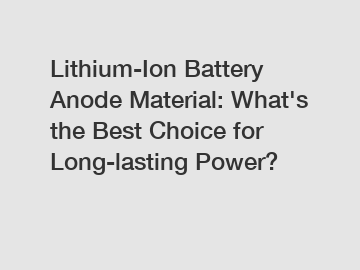Lithium-Ion Battery Anode Material: What's the Best Choice for Long-lasting Power?
With competitive price and timely delivery, Lianjing sincerely hope to be your supplier and partner.
In the world of energy storage, lithium-ion batteries have emerged as the go-to choice for a wide range of applications, from powering smartphones and laptops to storing renewable energy from solar panels and wind turbines. These batteries have revolutionized the way we power our devices and homes, offering high energy density, long cycle life, and fast charging capabilities.
One of the key components of a lithium-ion battery is the anode material, which plays a crucial role in determining the overall performance and longevity of the battery. The anode is the electrode where lithium ions are stored during charging and released during discharging. Choosing the right anode material is therefore essential for ensuring long-lasting power and performance.

There are several different types of anode materials that can be used in lithium-ion batteries, each with its advantages and disadvantages. Some of the most commonly used anode materials include graphite, silicon, and lithium titanate. Each material has its unique characteristics and performance attributes that make it suitable for different applications.
Graphite is the most commonly used anode material in lithium-ion batteries due to its stability, low cost, and high conductivity. Graphite anodes have a long cycle life and can provide a stable voltage output, making them ideal for applications where longevity and reliability are essential. However, graphite anodes have a limited energy density, which can restrict the overall capacity of the battery.
On the other hand, silicon anodes offer a higher energy density compared to graphite, making them an attractive option for applications where maximizing energy storage capacity is crucial. Silicon anodes can store more lithium ions, allowing the battery to store more energy in a smaller space. However, silicon anodes are prone to volume expansion and contraction during charging and discharging, which can lead to mechanical degradation and reduced cycle life.
Lithium titanate is another anode material that is gaining popularity for its fast charging capabilities and long cycle life. Lithium titanate anodes have a high rate capability, allowing the battery to be charged and discharged quickly without sacrificing performance or longevity. Additionally, lithium titanate anodes have a stable voltage output, making them ideal for applications where consistent power delivery is critical.
While each anode material has its advantages and disadvantages, the best choice for long-lasting power ultimately depends on the specific requirements of the application. For example, if longevity and stability are the primary concerns, graphite anodes may be the best choice. If maximizing energy storage capacity is the goal, silicon anodes may be more suitable. And if fast charging and high rate capability are essential, lithium titanate anodes may be the ideal option.
In recent years, researchers and manufacturers have been exploring new anode materials that offer improved performance and durability. Materials such as silicon-carbon composites, tin-based alloys, and metal oxides are being investigated for their potential to enhance the energy density, cycle life, and rate capability of lithium-ion batteries.
Developing advanced anode materials is crucial for overcoming the limitations of current lithium-ion battery technology and unlocking new opportunities for energy storage in applications such as electric vehicles, grid energy storage, and portable electronics. By continuously pushing the boundaries of anode material research and innovation, we can create batteries that are more efficient, reliable, and sustainable.
In conclusion, the choice of anode material plays a significant role in determining the performance and longevity of lithium-ion batteries. Each material has its unique characteristics and performance attributes that make it suitable for different applications. Whether it's stability, energy density, fast charging, or long cycle life, there is no one-size-fits-all solution when it comes to selecting the best anode material for long-lasting power. By continuing to research and develop new anode materials, we can drive innovation in energy storage and create batteries that meet the diverse needs of our modern world.
If you are looking for more details, kindly visit our website.
Want more information on Graphite Crucible for Sale? Feel free to contact us.



